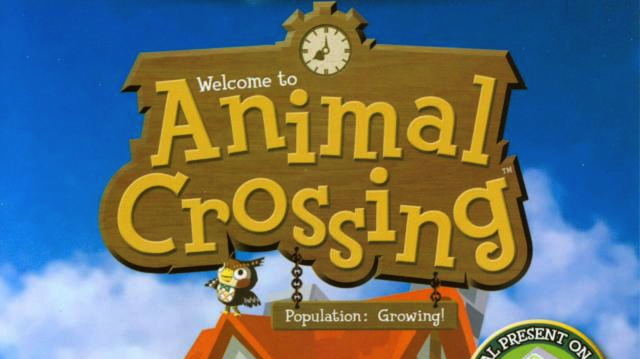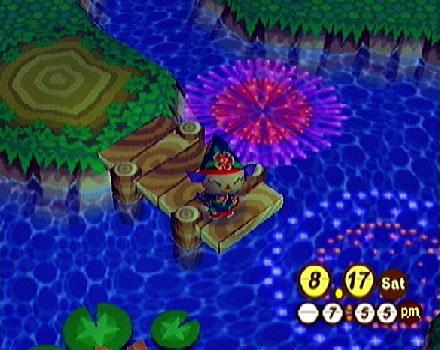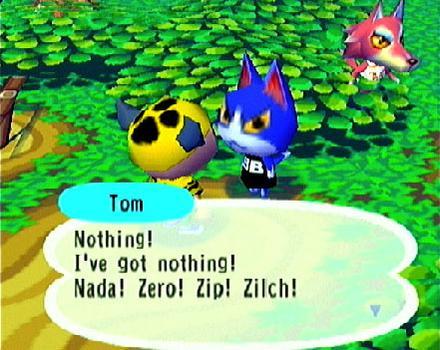
|
Ten years ago this month, a strange little GameCube curiosity called Animal Crossing made its way to North American shores. I knew very little about the game at the time; aside from a brief preview in EGM, I was hardly aware it even existed, but seeing an advert for it tucked away in Super Mario Sunshine’s case, with its grand claims of a real-time, persistent world that would continually change even if you weren’t there to experience it, was enough to convince me to purchase the game on launch day.
Of course, as novel as its premise sounded, “life sims” of this sort were nothing new in the games industry; EA’s burgeoning Sims franchise had already captured the attention of millions of gamers– my sister among them– by the time of its release, and Natsume’s Harvest Moon (which would likewise sink its hooks in her a couple of years down the line) continued to prosper in its own comfortable niche. Animal Crossing, by virtue of its play mechanics, came off as a hybrid of the two: players had direct control over their avatars just as they did in Natsume’s titles, but their objective was simply to earn money (or “Bells”) and eke out a virtual living, much as they’d do in The Sims. And yet, despite taking clear influences from both of the aforementioned series, there was something distinctly unique about the entire experience, something that was able to set it apart from other life games and place it in a strata all its own. That thing, ironically enough, was the harvest moon.
Though to be honest, it could have just as easily been Halloween, or the “Harvest Festival” (Thanksgiving), or the fireworks show– any holiday, really, as they all went a long way in fostering a distinct sense of community that was absent in previous life sims. It just so happened that the harvest moon was the first to occur after its release, making it– at least, for me– the most memorable of its communal gatherings.

It also helped that its core gameplay was surprisingly compelling, giving fans a reason to come back to their towns every day. A trip to your village typically consisted of chatting with your neighbors, running the occasional errand, catching a few fish or insects (which could then either be sold or donated to the museum depending on their rarity), playing amateur archeologist, and shopping at the local store. Yet what made these activities so enjoyable was their unpredictability. Each day was a little different from the previous one; Nook would have a fresh supply of merchandise stocked in his store, neighbors would spout different sayings and offer different jobs to undertake, and new wildlife would emerge depending on the time and season. Some characters, like the roaming carpet vendor Sahara or the starving artist Wendell, would even make a random appearance in your town (though you could learn of their arrival in advance by talking to the police dog Copper), reinforcing the illusion that your village was alive and continually changing with each passing day.
The fun wasn’t limited to just a single player, either. While later titles, particularly City Folk, would add Wi-Fi support to their list of features, allowing for simultaneous play with your real-life group of friends, Animal Crossing’s solution to multiplayer, however inelegant it might have been, was very much in keeping with the spirit of the game. Up to four players could occupy a single town, making up a sort of gated community near the village entrance, but only one could ever explore it at a given time. At first blush this seemed like a restrictive setup for co-operative play– and to an extent it was, as it meant players had to take turns playing the game in order to make any individual progress– but soon enough it became clear just why it was structured this way, especially if you had siblings (or even parents) with whom to share your file. Since only one person could explore the village at a time, the other players typically had to wait until the system was free, whether it be because of diverging schedules or some other reason, to have their turn with the game. Part of the fun, then, became seeing how your town had changed in your absence. New notes could be posted on the bulletin board, flowers and trees could be rearranged or thinned out, and– depending on how nice your co-inhabitants were– items could even be left for you to find. All of this added to the game’s unpredictability, giving players another reason to return to it as often as possible.

You could even travel to another person’s village via your memory card, expanding the scope of the game’s world. It was startling to see just how wildly towns could vary in terms of their layouts and inhabitants; not only would all of the shops be located in different parts of the forest, but even the very geography of the village would be molded differently. Neighbors, too, would seldom overlap with the ones in your town (thanks to the game’s large selection of characters), and you could even take a random one home with you– in exchange for one of your own– at the conclusion of your trip. Unfortunately, this, too, was also hampered by the game’s restrictive multiplayer, but the infrequency of these visits, especially in a pre-online world, made them feel special nonetheless.
Most of all, Animal Crossing stood as a direct counterpoint to many of the games at the time, particularly Star Fox Adventures, with which it shared its release month. Rare’s epic was one of the most anticipated titles of the year, a gorgeous, sprawling adventure that was said to rival Nintendo’s own Legend of Zelda series in scale and quality. Animal Crossing, by contrast, was a Nintendo 64 holdover, decidedly uglier (at least by GameCube standards) in its visuals and far more intimate in its scope. Yet in spite of all this, the game was able to not only set itself apart from its prettier rivals, but it even went on to eclipse Rare’s title in lifetime sales. That we’re waiting on the fourth installment in what has become one of Nintendo’s most lucrative new franchises speaks volumes to the original’s legacy. After all, how many new Star Fox games have we had in the wake of Adventures?




 ShareThis
ShareThis







